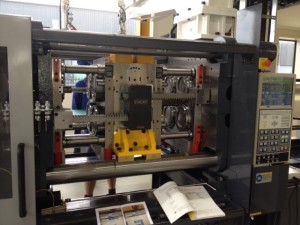on Wednesday, December 2nd, 2015
Plastic Injection moulding is increasingly competitive in the current economic climate. To produce moulded plastic parts competitively, manufacturers are constantly looking for an edge. Margins are often small and customers always want a better deal.
In simple terms consumer demand determines the volumes of parts required. This together with part size normally dictates the moulding machine required (shot volume and platen size).
Once you have determined the moulding machine and the cavitation of the mould, you have your capital expenditure. To produce the part, polymer price and cycle time determine the unit cost.
The cycle time is divisible by the number of cavities. This is why we see ever increasing numbers of high cavitation mould tools, 64 cavity moulds and upwards.
These tools are often very large and so need large moulding machines and therefor high capital expenditure and running costs.
So if we could double the productivity of the same moulding machine with a similar capital expenditure, then we can drive down the unit cost.
By using a stack mould, you can double the number of tool part lines and double the number of cavities, literally halving your cycle time.
A stack mould tool is a great way of maximising productivity:
Designing and building a stack mould tool has many considerations. Customer input and material selection along with RPM International Tool & Die’s design, automation and engineering expertise are all important dynamics to maximise, to achieve the best result for your application.When designing your tool we look at incorporating:
 Robust mould design for tool life duration.
Robust mould design for tool life duration.It is the traditional view that a stack mould tool is designed specifically to fit in to a particular moulding machine and that it is generally positioned there on a mostly permanent basis, being tricky and time consuming to install and uninstall.
Today, this is not necessarily true. With modern design and techniques, stack mould tools can be built to be easily loaded and unloaded in to a moulding machine. Each moulding machine has slightly different specifications and dimensions. Bearing this in mind, smart design and skilled manufacture are crucial to optimising the benefits of a stack mould project.
A two level stack mould tool consists of a centre section, this is the injection side of the mould and is connected to the machine injection nozzle. The cavity nozzles are opposing either directly or offset, so the polymer is injected from the centre section out into the cavities in both directions.
The other sides of the moulds are bolted to the FH and MH platens of the moulding machine. A gear or lever system is used to control the movement of the centre section as the MH platen moves away during tool opening sequence.
The centre section also moves away from the FH platen, at half the rate of the MH platen. The tool expands and retracts horizontally, making optimal use of the full shut height of the moulding machine, allowing the moving sections to fully open and close accordingly in each cycle.
The shut height in the moulding machine is fully utilised to manage the increased output schedule. The tool will open and close both part surfaces with perfect timing , using a system such as rack and pinion gear, harmonic lever system, hydraulic push-pull system or a helical gear system.
The stack mould tool would have the same footprint as a conventional single face mould and only requires the same clamp tonnage as a conventional mould because the injection force is opposing. So the clamp tonnage required for a 4+4, 8 cavity stack mould is equivalent to a conventional single face 4 cavity mould.
Mould cavity shapes can be different to each other to produce families of components on each shot.
The types of product that can be produced in a stack mould are only limited to the size of the tool. Stack mould tools are used typically to produce:
RPM has designed and produced many successful stack mould tools and our latest project has surpassed expectations and delighted our customer. See the case study here. We invest heavily in the latest technology to insure we stay at the forefront of industry, our facility in Auckland is world class and we operate on a global scale.
RPM offer a full design and build service with almost 30 years of experience in the business. Reduce your component cost and gain a competitive advantage with our help and expertise. Our tool making, engineering, automation and design services are available to our global customers and we welcome your inquiries and input at all levels of our service.
In February 2015, RPM were delighted to commence design of a stack mould tool for Tekplas Ltd – see the case study here.
Written by Steven Binks.